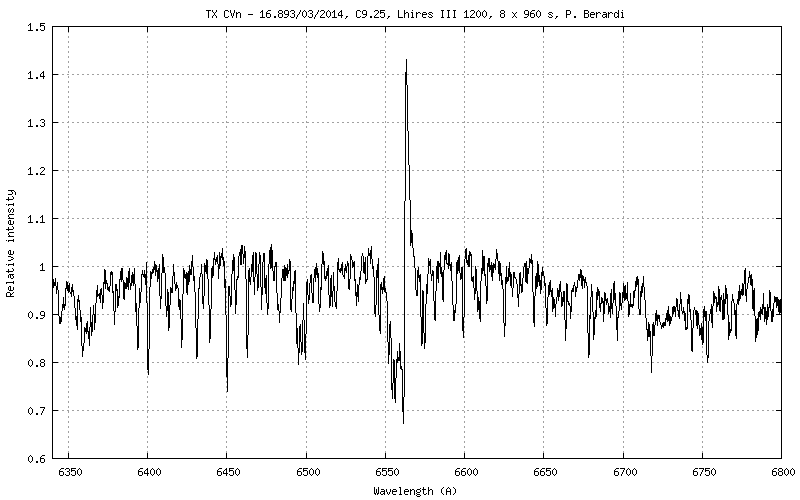TX CVn detected in active state by U. Manari & al.
Current mag V = 9.9
Spectra are welcome .
There's a place for them in the provisional ARAS Data Base :
http://www.astrosurf.com/aras/Aras_Data ... /TXCVn.htm
Spectra to be sent to francoismathieu.teyssier@bbox.fr
Spectrum of TX CVn (low state) :
http://www.astronomie-amateur.fr/AtlasS ... _Lisa.html
Best regards
François Teyssier
Title: The symbiotic star TX CVn has entered an active state
Author: U. Munari (INAF Padova-Asiago), F. Castellani, P. Valisa,
S. Dallaporta, G. Cherini, A. Vagnozzi, G. L. Righetti, R. Belligoli
(ANS Collaboration)
Queries: ulisse.munari@oapd.inaf.it
Posted: 14 Jan 2014; 15:56 UT
Subjects:Optical, Cataclysmic Variable
After the last active phase that begun in 2003, the symbiotic star TX CVn
has now entered a new active phase. In 2003, TX CVn rose to B=10.5 and
there it remained until the end of 2007 (Skopal 2007, AN 328, 909), when
we started monitoring the variable with various ANS Collaboration telescopes
in BVRI bands.
Our observations show that the star has spent the following 6 years on
a steady decline at a rate of 0.084 mag per year in the B band, that took it from
B=10.55 on December 2007 to B=11.02 on September 2013, when the star begun
a rapid brightening, reaching B=10.65 by early December 2013. Our last measurements
for 12 and 13 January 2014 provide B=10.72, B-V=+0.78, V-Rc=+0.62, V-Ic=+1.36.
TX CVn is a enigmatic P=199 days binary star composed by a K5III and what
looks like a B9 shell star (Kenyon and Garcia 1989, AJ 97, 194), engulfed
by a large external dust shell at a temperature of 450 K (Kenyon 1988, AJ
96, 337). TX CVn remained around B=11.8 for the first half century of its long
recorded photometric history. Then, around 1945 it begun a slow and gradual
rise in brightness that reached B=10.1 mag in 1967, a level at which the system
remained until 1990 when a slow decline begun (Skopal 2005, Astron.Astrophys. 440,
995). On top of this, several outbursts occurred, the largest ones
recorded on 1920, 1945, 1952, and 1962, when a peak brightness between
B=9.0 and 9.5 mag was always attained.
A low resolution spectrum (range 3890-8520 Ang, dispersion 2.1 Ang/pix)
of TX CVn has been obtained on 12 January 2014 with the Varese 0.61m
telescope equipped with the Multi-Mode Spectrograph. At the shortest
wavelengths, the spectrum shows a reinforced B9 shell spectrum, while the
K5III continues to dominate in the red. Spectral monitoring with the Asiago
1.22m and 1.82m telescopes shows that over the period 2008-2013 the B9
shell spectrum smoothly declined in intensity, paralleling the decline in B-band
brightness. The 12 January 2014 spectrum presents Halpha
in moderate emission with a strong P-Cyg profile, blue-shifted by 330 km/s
with respect to the emission component. No other emission line is readily
visible.
Symbiotic TX CVn in hight state
-
Francois Teyssier
- Posts: 1521
- Joined: Fri Sep 23, 2011 1:01 pm
- Location: Rouen
- Contact:
Symbiotic TX CVn in hight state
François Teyssier
http://www.astronomie-amateur.fr
http://www.astronomie-amateur.fr
-
Paolo Berardi
- Posts: 578
- Joined: Thu Sep 29, 2011 10:51 pm
Re: Symbiotic TX CVn in hight state
Observation of 16 march, Lhires III 1200:

H-Alpha line intensity (EW) is slightly decreased compared to 15 january observation. From AAVSO data, V mag is now about 10.
Paolo

H-Alpha line intensity (EW) is slightly decreased compared to 15 january observation. From AAVSO data, V mag is now about 10.
Paolo